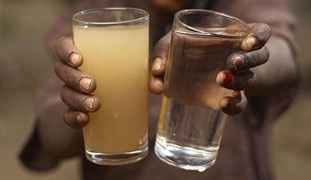For you and me, obtaining safe drinking water may be as simple as walking to the nearest sink and getting a cup of tap water. But 29% of people worldwide do not have ready access to safe drinking water, instead getting their water from sources contaminated by feces. This leads to over half a million deaths annually. Climate change and population growth are expected to exacerbate the issue, making access to potable water even more challenging.
One solution to this problem is by making salt water drinkable through desalination. But the most commonly used technique for desalination, reverse osmosis, requires large inputs of energy to boil water, making it unsuitable for places without reliable electricity.
With this in mind, Yale researchers in the School of Engineering and Applied Science, in collaboration with scientists at Rice University, Arizona State University, and the University of Texas-El Paso, are working to improve an alternative solar-powered desalination method known as membrane distillation. This process has the potential to be less energy-intensive than reverse osmosis, making it suitable for underdeveloped areas and environmentally friendly.
In membrane distillation, salt water and pure water are placed on opposite sides of a membrane which only allows gases to pass through. The salty side is heated while the pure water is cooled. The difference in partial pressure causes the water on the salty side to travel through the membrane as a gas, leaving the salt and other contaminants as solids on the “dirty” side of the .
Membrane distillation has not been widely used for a number of reasons. Energy is required to generate and maintain the temperature difference between the impure salt water and clean freshwater reservoirs, and the process uses more energy to produce the same amount of pure water when compared to reverse osmosis. Along with their collaborators, Yale researchers Menachem Elimelech and Akshay Deshmukh have optimized a low-energy membrane distillation technique that uses solar power coupled with nanoparticle technology.
Their design uses a carbon black-coated membrane that maximizes uptake of solar energy. This sets up a temperature gradient in which the salt water closest to the nanoparticle-covered membrane heats up. The process does not require an additional power source besides solar energy, and the materials are widely available.
While the nanoparticle-enabled solar membrane distillation system is still in development, the scientists have demonstrated its viability with a paper recently published in the Proceedings of the National Academy of Sciences. The project is attracting attention because of its potential applications around the world, especially in areas lacking access to electricity.
The improved membrane distillation design is ideal for smaller, decentralized applications like a rural village not connected to the grid. Unlike reverse osmosis, which necessitates a proper electrical connection for the high-pressure pumps, the new solar membrane distillation model requires very little infrastructure. “We wouldn’t use a process like this to compete with reverse osmosis, in a big community,” said Deshmukh. “But for smaller stuff, which is off grid, it could be useful because it’s using sunlight and it’s not a high-pressure process.”
Membrane distillation technology can also be used to remove other contaminants besides salt from water. “This could be used in situations where the water is very dirty, stuff like waste water from industrial sites where the osmotic pressure is very high, so reverse osmosis can’t be used to treat it because the membranes can’t deal with the pressure,” said Deshmukh. He also thinks their design could be implemented in natural disaster situations, where normal water treatment infrastructure has been disrupted.
Though the researchers have produced a model of the design, the technology is not yet ready to hit store shelves. The scientists now need to refine their design and market approach. While there is still work to be done, they believe that the new technology will improve many lives around the globe by providing much needed access to clean water.

